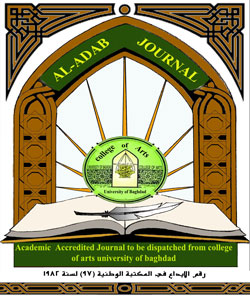The social and behavioral effects of home quarantine in the Covid-19 pandemic on a sample of married female students at the University of Sharjah
DOI:
https://doi.org/10.31973/aj.v1i148.4260Keywords:
home quarantine , University of Sharjah , COVID-19 pandemic , female studentsAbstract
This study aimed to identify the effects of home quarantine on the family. The study was applied to a sample of female students from the University of Sharjah, with the aim of identifying the negative social and behavioral effects on the family.
The study was conducted on a sample of (118) married female students at the University of Sharjah, Department of Sociology, through designing a questionnaire and conducting a direct interview with (12) 12 families live in Sharjah.
The study includes three chapters, the first chapter deals with the problem of the study, the second chapter deals with theoretical trends and previous studies, and the third chapter deals with the field study and data analysis.
Among the most important findings of the study are: The conditions of home quarantine and social distancing were not completely suitable for children's education. Less communication with relatives and friends As a result of that stone, there was great difficulty in reconciling family and academic situations. Addictive behavior appeared on the use of social media for both spouses. The spouses and children became afraid of grocery items, and they resorted forcefully and sterilized them constantly. The behavior of mood swings and nervousness was one of the biggest problems that all family members faced, as the study showed. Sleep disruption is the most dangerous for children.
Downloads
References
عطية، جرجي شاهين. (2000) المعتمد. بيروت، دار صادر
قاموس ومعجم المعاني، متاح على الرابطwww.almaany.com
السون وولف، رت والاس، (2005). النظرية المعاصرة في علم الاجتماع تمدد آفاق النظرية الكلاسكية. (ترجمة حوراني، محمد عبد الكريم)، طبعة 1، عمان-الاردن: دار مجدلاوي للنشر والتوزيع.
حمدي، عبد العال (2021) تصور مقترح من منظور الممارسة العامة للخدمة الاجتماعية للحد من المشكلات الأسرية الناتجة عن جائحة كورونا لدى الأسرة المصرية. مجلة كلية الخدمة الاجتماعية للدراسات والبحوث الاجتماعية جامعة الفيوم. المعهد العالي للخدمة الاجتماعية بقنا.
أبو القاسم، سالم (2020)، التباعد الاجتماعي والحجر المنزلي وتداعياتها على الاسره في ظل جائحة: دراسة حالة، جمعة المرقب –كلية الآداب والعلوم مسلاته. العدد (14)
الخليفة، فادية (2021) واقع العنف الأسري أثناء الحجر المنزلي لمنع تفشي كوفد-19: دراسة كيفية على حالات من العنفات المراجعات لمستشفيات محافظة الأحساء. مجلة العلوم الإنسانية والاجتماعية. جامعة الإمام محمد بن سعود الإسلامية – عمادة البحث العلمي. العدد (61).
Nada A. Al-Mulla1 and Ziyad R. Mahfoud, 2022, The impact of the COVID-19 lockedown home quarantine on the physical activity and lifestyle of children in Qatar, Volume 10 - 2022 https://doi.org/10.3389/fpubh.2022.877424
Elisa Di Giorgio1 · Daniela Di Riso · Giovanna Mioni · Nicola Cellini (2020), The interplay between mothers’ and children behavioral and psychological factors during COVID‑19: an Italian study, European Child & Adolescent Psychiatry volume 30, pages1401–1412 (2021)
أعراب، محمد (2020) في الحاجة إلى سوسيولوجيا الصحة والجسد في زمن جائحة كورونا. تمثلات الاسرة لجسد الطفل – دراسة نفسية – اجتماعية في أنماط التعامل مع الجسد. المدرسة العليا للتكنولوجيا- جامعة مولاي إسماعيل – مكناس
الاسمري، سعيد (2020) مهددات الصحة النفسية المرتبطة بالحجر المنزلي أثر فيروس كورونا المستجد. المجلة العربية للدراسات الأمنية. جامعة نايف العربية للعلوم الأمنية. العدد (2).
Downloads
Published
Issue
Section
License
Copyright (c) 2024 رانيا محمد الحسن عبد الله، أ.د. خليل عبد الله المدني

This work is licensed under a Creative Commons Attribution 4.0 International License.
Copyright and Licensing:
For all articles published in Al-Adab journal, copyright is retained by the authors. Articles are licensed under an open access Creative Commons CC BY 4.0 license, meaning that anyone may download and read the paper for free. In addition, the article may be reused and quoted provided that the original published version is cited. These conditions allow for maximum use and exposure of the work.
Reproducing Published Material from other Publishers: It is absolutely essential that authors obtain permission to reproduce any published material (figures, schemes, tables or any extract of a text) which does not fall into the public domain, or for which they do not hold the copyright. Permission should be requested by the authors from the copyrightholder (usually the Publisher, please refer to the imprint of the individual publications to identify the copyrightholder).
Permission is required for: Your own works published by other Publishers and for which you did not retain copyright.
Substantial extracts from anyones' works or a series of works.
Use of Tables, Graphs, Charts, Schemes and Artworks if they are unaltered or slightly modified.
Photographs for which you do not hold copyright.
Permission is not required for: Reconstruction of your own table with data already published elsewhere. Please notice that in this case you must cite the source of the data in the form of either "Data from..." or "Adapted from...".
Reasonably short quotes are considered fair use and therefore do not require permission.
Graphs, Charts, Schemes and Artworks that are completely redrawn by the authors and significantly changed beyond recognition do not require permission.
Obtaining Permission
In order to avoid unnecessary delays in the publication process, you should start obtaining permissions as early as possible. If in any doubt about the copyright, apply for permission. Al-Adab Journal cannot publish material from other publications without permission.
The copyright holder may give you instructions on the form of acknowledgement to be followed; otherwise follow the style: "Reproduced with permission from [author], [book/journal title]; published by [publisher], [year].' at the end of the caption of the Table, Figure or Scheme.











